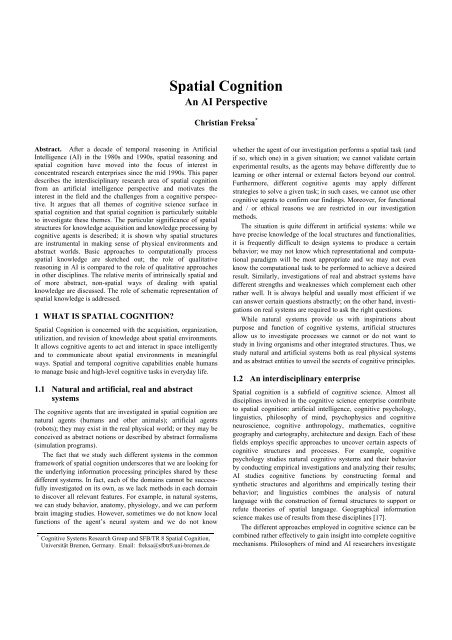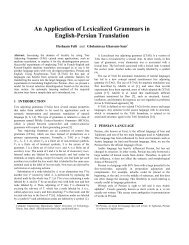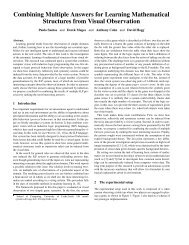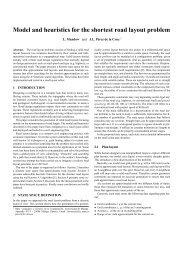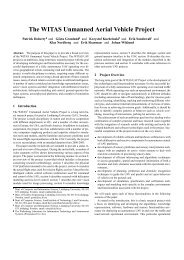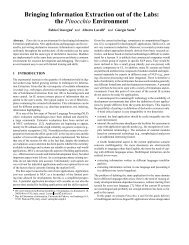Spatial Cognition - Frontiers in Artificial Intelligence and Applications ...
Spatial Cognition - Frontiers in Artificial Intelligence and Applications ...
Spatial Cognition - Frontiers in Artificial Intelligence and Applications ...
You also want an ePaper? Increase the reach of your titles
YUMPU automatically turns print PDFs into web optimized ePapers that Google loves.
<strong>Spatial</strong> <strong>Cognition</strong>An AI PerspectiveChristian Freksa *Abstract. After a decade of temporal reason<strong>in</strong>g <strong>in</strong> <strong>Artificial</strong><strong>Intelligence</strong> (AI) <strong>in</strong> the 1980s <strong>and</strong> 1990s, spatial reason<strong>in</strong>g <strong>and</strong>spatial cognition have moved <strong>in</strong>to the focus of <strong>in</strong>terest <strong>in</strong>concentrated research enterprises s<strong>in</strong>ce the mid 1990s. This paperdescribes the <strong>in</strong>terdiscipl<strong>in</strong>ary research area of spatial cognitionfrom an artificial <strong>in</strong>telligence perspective <strong>and</strong> motivates the<strong>in</strong>terest <strong>in</strong> the field <strong>and</strong> the challenges from a cognitive perspective.It argues that all themes of cognitive science surface <strong>in</strong>spatial cognition <strong>and</strong> that spatial cognition is particularly suitableto <strong>in</strong>vestigate these themes. The particular significance of spatialstructures for knowledge acquisition <strong>and</strong> knowledge process<strong>in</strong>g bycognitive agents is described; it is shown why spatial structuresare <strong>in</strong>strumental <strong>in</strong> mak<strong>in</strong>g sense of physical environments <strong>and</strong>abstract worlds. Basic approaches to computationally processspatial knowledge are sketched out; the role of qualitativereason<strong>in</strong>g <strong>in</strong> AI is compared to the role of qualitative approaches<strong>in</strong> other discipl<strong>in</strong>es. The relative merits of <strong>in</strong>tr<strong>in</strong>sically spatial <strong>and</strong>of more abstract, non-spatial ways of deal<strong>in</strong>g with spatialknowledge are discussed. The role of schematic representation ofspatial knowledge is addressed.1 WHAT IS SPATIAL COGNITION?<strong>Spatial</strong> <strong>Cognition</strong> is concerned with the acquisition, organization,utilization, <strong>and</strong> revision of knowledge about spatial environments.It allows cognitive agents to act <strong>and</strong> <strong>in</strong>teract <strong>in</strong> space <strong>in</strong>telligently<strong>and</strong> to communicate about spatial environments <strong>in</strong> mean<strong>in</strong>gfulways. <strong>Spatial</strong> <strong>and</strong> temporal cognitive capabilities enable humansto manage basic <strong>and</strong> high-level cognitive tasks <strong>in</strong> everyday life.1.1 Natural <strong>and</strong> artificial, real <strong>and</strong> abstractsystemsThe cognitive agents that are <strong>in</strong>vestigated <strong>in</strong> spatial cognition arenatural agents (humans <strong>and</strong> other animals); artificial agents(robots); they may exist <strong>in</strong> the real physical world; or they may beconceived as abstract notions or described by abstract formalisms(simulation programs).The fact that we study such different systems <strong>in</strong> the commonframework of spatial cognition underscores that we are look<strong>in</strong>g forthe underly<strong>in</strong>g <strong>in</strong>formation process<strong>in</strong>g pr<strong>in</strong>ciples shared by thesedifferent systems. In fact, each of the doma<strong>in</strong>s cannot be successfully<strong>in</strong>vestigated on its own, as we lack methods <strong>in</strong> each doma<strong>in</strong>to discover all relevant features. For example, <strong>in</strong> natural systems,we can study behavior, anatomy, physiology, <strong>and</strong> we can performbra<strong>in</strong> imag<strong>in</strong>g studies. However, sometimes we do not know localfunctions of the agent’s neural system <strong>and</strong> we do not know*Cognitive Systems Research Group <strong>and</strong> SFB/TR 8 <strong>Spatial</strong> <strong>Cognition</strong>,Universität Bremen, Germany. Email: freksa@sfbtr8.uni-bremen.dewhether the agent of our <strong>in</strong>vestigation performs a spatial task (<strong>and</strong>if so, which one) <strong>in</strong> a given situation; we cannot validate certa<strong>in</strong>experimental results, as the agents may behave differently due tolearn<strong>in</strong>g or other <strong>in</strong>ternal or external factors beyond our control.Furthermore, different cognitive agents may apply differentstrategies to solve a given task; <strong>in</strong> such cases, we cannot use othercognitive agents to confirm our f<strong>in</strong>d<strong>in</strong>gs. Moreover, for functional<strong>and</strong> / or ethical reasons we are restricted <strong>in</strong> our <strong>in</strong>vestigationmethods.The situation is quite different <strong>in</strong> artificial systems: while wehave precise knowledge of the local structures <strong>and</strong> functionalities,it is frequently difficult to design systems to produce a certa<strong>in</strong>behavior; we may not know which representational <strong>and</strong> computationalparadigm will be most appropriate <strong>and</strong> we may not evenknow the computational task to be performed to achieve a desiredresult. Similarly, <strong>in</strong>vestigations of real <strong>and</strong> abstract systems havedifferent strengths <strong>and</strong> weaknesses which complement each otherrather well. It is always helpful <strong>and</strong> usually most efficient if wecan answer certa<strong>in</strong> questions abstractly; on the other h<strong>and</strong>, <strong>in</strong>vestigationson real systems are required to ask the right questions.While natural systems provide us with <strong>in</strong>spirations aboutpurpose <strong>and</strong> function of cognitive systems, artificial structuresallow us to <strong>in</strong>vestigate processes we cannot or do not want tostudy <strong>in</strong> liv<strong>in</strong>g organisms <strong>and</strong> other <strong>in</strong>tegrated structures. Thus, westudy natural <strong>and</strong> artificial systems both as real physical systems<strong>and</strong> as abstract entities to unveil the secrets of cognitive pr<strong>in</strong>ciples.1.2 An <strong>in</strong>terdiscipl<strong>in</strong>ary enterprise<strong>Spatial</strong> cognition is a subfield of cognitive science. Almost alldiscipl<strong>in</strong>es <strong>in</strong>volved <strong>in</strong> the cognitive science enterprise contributeto spatial cognition: artificial <strong>in</strong>telligence, cognitive psychology,l<strong>in</strong>guistics, philosophy of m<strong>in</strong>d, psychophysics <strong>and</strong> cognitiveneuroscience, cognitive anthropology, mathematics, cognitivegeography <strong>and</strong> cartography, architecture <strong>and</strong> design. Each of thesefields employs specific approaches to uncover certa<strong>in</strong> aspects ofcognitive structures <strong>and</strong> processes. For example, cognitivepsychology studies natural cognitive systems <strong>and</strong> their behaviorby conduct<strong>in</strong>g empirical <strong>in</strong>vestigations <strong>and</strong> analyz<strong>in</strong>g their results;AI studies cognitive functions by construct<strong>in</strong>g formal <strong>and</strong>synthetic structures <strong>and</strong> algorithms <strong>and</strong> empirically test<strong>in</strong>g theirbehavior; <strong>and</strong> l<strong>in</strong>guistics comb<strong>in</strong>es the analysis of naturallanguage with the construction of formal structures to support orrefute theories of spatial language. Geographical <strong>in</strong>formationscience makes use of results from these discipl<strong>in</strong>es [17].The different approaches employed <strong>in</strong> cognitive science can becomb<strong>in</strong>ed rather effectively to ga<strong>in</strong> <strong>in</strong>sight <strong>in</strong>to complete cognitivemechanisms. Philosophers of m<strong>in</strong>d <strong>and</strong> AI researchers <strong>in</strong>vestigate
3 SPACE-BASED CONCEPTREPRESENTATIONCognitive representations can make use of perceptual structuresthat have been developed dur<strong>in</strong>g the process of adaptation to theenvironment. In the space-based approach that will be outl<strong>in</strong>ed <strong>in</strong>this chapter, knowledge is represented <strong>in</strong> terms of environmentrelatedconcepts like <strong>in</strong> front of or beh<strong>in</strong>d that are anchored <strong>in</strong>spatial relations between physical objects <strong>in</strong> the real world, ratherthan <strong>in</strong> terms of general abstract notions like zero or one, on or off,true or false. It has been shown <strong>in</strong> the cognitive science literaturethat explicit semantic connections to the problem doma<strong>in</strong> can beprocessed more appropriately than their logic abstractions [20].3.1 Doma<strong>in</strong>-specific vs. general representationformatWhat difference does the relation to the spatial environmentmake? First of all, we recognize the disadvantage of representationsthat are connected to specific entities: these representationsare not as general as abstract representations that could be <strong>in</strong>stantiatedby arbitrary entities. This is a reason why we <strong>in</strong>troduce theadvantages of algebra over calculus <strong>in</strong> mathematics <strong>and</strong> theexploitation of tautologies over truth table manipulation logics.As long as we deal with complete <strong>and</strong> certa<strong>in</strong> knowledge,abstract representations <strong>in</strong> fact are superior as certa<strong>in</strong> reason<strong>in</strong>gsteps may be taken without reference to the object doma<strong>in</strong>; if weare deal<strong>in</strong>g with <strong>in</strong>complete <strong>and</strong> uncerta<strong>in</strong> knowledge, thesituation may be different. In the follow<strong>in</strong>g, I will consider the useof space-based representations to reason about spatial relations.3.2 Exploit<strong>in</strong>g spatial structures for reason<strong>in</strong>gThe power of abstract reason<strong>in</strong>g does not come for free. Whencognitive agents must reason on the basis of <strong>in</strong>complete oruncerta<strong>in</strong> knowledge – the st<strong>and</strong>ard situation for cognitive agents –they may only be able to draw logic <strong>in</strong>ferences if they cansubstitute for the miss<strong>in</strong>g knowledge by good guesses. Goodguesses may come from a good theory or from well-<strong>in</strong>formedknowledge sources. A good theory may provide default values thatcan support reason<strong>in</strong>g processes <strong>in</strong> st<strong>and</strong>ard situations. A well<strong>in</strong>formedknowledge source may complete miss<strong>in</strong>g knowledge justas needed. The former approach employs underst<strong>and</strong><strong>in</strong>g of thegeneral situation while the latter approach employs <strong>in</strong>formants thatneed not underst<strong>and</strong> what is go<strong>in</strong>g on.3.2.1 World knowledge <strong>and</strong> doma<strong>in</strong> knowledgeThe <strong>in</strong>terest<strong>in</strong>g case is the case of the ‘good theory’. ‘Generalknowledge’ comes <strong>in</strong> two varieties: (1) relat<strong>in</strong>g to the whole, orevery member of a class or category (the mathematical sense of‘general’); <strong>and</strong> (2) be<strong>in</strong>g usually the case; true or applicable <strong>in</strong>most <strong>in</strong>stances, but not all (the colloquial sense of ‘general’). Hereaga<strong>in</strong>, the former is the more <strong>in</strong>terest<strong>in</strong>g: knowledge that alwaysholds will be even more valuable for logic <strong>in</strong>ferences thanknowledge that usually holds. Can we separate the two types ofknowledge?Knowledge that always holds is world knowledge; it expressespr<strong>in</strong>ciples or laws of the world. Knowledge that usually orfrequently holds is doma<strong>in</strong> knowledge. Both types of knowledgeare useful, but if we can separate the two, we may be able todist<strong>in</strong>guish necessary <strong>and</strong> plausible consequences.<strong>Spatial</strong> structures can provide us with knowledge aboutnecessary implications of spatial relations <strong>and</strong> actions. They canbe used to replicate spatial relations <strong>in</strong> the real world <strong>and</strong> thusimplicitly fill <strong>in</strong> miss<strong>in</strong>g relations that we don’t explicitly know.<strong>Spatial</strong> <strong>and</strong> spatio-temporal structures have the advantage of be<strong>in</strong>ggeneral enough to support a large scope of cognitively relevantfeatures <strong>and</strong> phenomena <strong>and</strong> restrictive enough to provide usefulconstra<strong>in</strong>ts for reason<strong>in</strong>g. Our hypothesis is that spatio-temporalphenomena form the basis for our thoughts <strong>and</strong> reason<strong>in</strong>g <strong>and</strong> canbe best supported by a spatio-temporal substrate.3.2.2 Sources of uncerta<strong>in</strong>tyWhen we deal with uncerta<strong>in</strong> knowledge, it is crucial that weunderst<strong>and</strong> the nature of the uncerta<strong>in</strong>ty. Cognitive agents mustlive with only partial knowledge about their environment <strong>and</strong> stilltake the right actions. Lack of knowledge about precise locations,durations, or actions affects local uncerta<strong>in</strong>ty much more than globaluncerta<strong>in</strong>ty. It is known that children learn laws of persistence<strong>and</strong> dynamics at an early age. Knowledge about spatio-temporalcoherence allows cognitive agents to make reliable predictionsdespite miss<strong>in</strong>g knowledge [7]. In our everyday actions <strong>in</strong> trafficetc. we rely on spatio-temporal coherence to control our actions.This <strong>in</strong>sight will enable us to resolve the uncerta<strong>in</strong>ty appropriately.Too abstract representations of the environment may onlytell us about alternative options <strong>in</strong> terms of logical disjunctions;this may be not enough to resolve uncerta<strong>in</strong>ty <strong>in</strong>telligently. Inspatio-temporal worlds, uncerta<strong>in</strong>ty almost always is a function ofspatio-temporal vic<strong>in</strong>ity due to the relevant laws of physics; thus,when we employ spatio-temporal representations that ma<strong>in</strong>ta<strong>in</strong>spatio-temporal coherence, we get <strong>in</strong>formation about vic<strong>in</strong>ity forfree. This <strong>in</strong>formation can be used to resolve perceptual <strong>and</strong><strong>in</strong>ferential uncerta<strong>in</strong>ty.3.3 Reason<strong>in</strong>g about non-spatial relationsIn the previous chapter I have given arguments, why space-basedrepresentations may be useful for reason<strong>in</strong>g about spatialsituations. In the present chapter I will argue that space-basedrepresentations may support cognition beyond the spatial doma<strong>in</strong>.3.3.1 Concept acquisition through perceptual experienceLet us go back to the concept acquisition process I discussed <strong>in</strong>section 2.2. Suppose we have a cognitive agent equipped withspatial concepts but no other concepts about its environment. Howcan children (or adults or artificial cognitive agents) acquire <strong>and</strong>communicate concepts that can not be directly related to thephysical environment through perception? Cognitive agents willbe able to form new concepts related to the environment if (1) aperceptual, (2) a conceptual, or (3) a comb<strong>in</strong>ation of a perceptual<strong>and</strong> a conceptual pattern gives rise to a new concept.In other words, new concepts can be formed if they havesometh<strong>in</strong>g <strong>in</strong> common with exist<strong>in</strong>g concepts or perceptions. Ifthey have everyth<strong>in</strong>g <strong>in</strong> common with exist<strong>in</strong>g concepts, they areno new concepts. If they have noth<strong>in</strong>g <strong>in</strong> common with exist<strong>in</strong>gconcepts, they cannot be related to experiences <strong>and</strong> therefore theycannot be generated. Mathematically speak<strong>in</strong>g, new concepts mustnot be orthogonal to exist<strong>in</strong>g concepts but they must have a certa<strong>in</strong>correspondence / association to exist<strong>in</strong>g ones. This enables us tounderst<strong>and</strong> new concepts <strong>in</strong> terms of established concepts.
3.3.2 Conceptual anchor<strong>in</strong>g non-spatial conceptsIf we assume that the early concepts we form about the world arespatial concepts rooted <strong>in</strong> the physical environment throughperception, it makes sense that we form subsequent concepts onthe basis of spatial concepts, <strong>in</strong> particular concepts that areexperientially related to spatial concepts – for example, temporalconcepts. In our perceptual experience, there is a strongcorrelation between duration <strong>and</strong> spatial distance: longer distancesusually take more time to travel than shorter distances, <strong>and</strong> we useexpressions like ‘it takes long to get there’ which make sense both<strong>in</strong> a spatial <strong>and</strong> <strong>in</strong> a temporal <strong>in</strong>terpretation.But time also passes without any distance be<strong>in</strong>g traveled. Thedifferences between physical distances we can measure with ayard stick <strong>and</strong> the experience that time can pass <strong>in</strong> which we canplay, th<strong>in</strong>k, dream, or wait without physically mov<strong>in</strong>g make itworthwhile to form a new concept ‘duration’. Nevertheless, it isvery hard, if not impossible, to describe temporal duration if wecannot resort to well-understood concepts like spatial distance thatcan be objectively characterized with reference to the physicalenvironment. For example, we can suggest that a given duration isthe time it would take to travel a certa<strong>in</strong> distance by certa<strong>in</strong> means;then we can abstract from the travel<strong>in</strong>g event; everyth<strong>in</strong>g elsebe<strong>in</strong>g equal, the duration persists. In fact, we may imag<strong>in</strong>etemporal durations <strong>in</strong> terms of distances traveled to get a bettergrasp at the concept of duration.3.3.3 The constructive approach <strong>in</strong> cognitionOther concepts like ‘speed’ may be developed accord<strong>in</strong>gly (whichconcept is more basic, ‘duration’ or ‘speed’?) <strong>and</strong> when we have agood h<strong>and</strong>le at everyday physical concepts, even more abstractconcepts may be formed with reference to the exist<strong>in</strong>g ones. Intheir theory of metaphors, Lakoff <strong>and</strong> Johnson [15] give plenty ofexamples that illustrate relationships between different concepts;such examples may serve to build up abstract concept structuresfrom concrete perceptual entities <strong>and</strong> relations. A great feature ofsuch conceptual structures is that we may be able to borrowcalculation or reason<strong>in</strong>g procedures from well-establishedconcepts for use <strong>in</strong> new conceptual structures when we lackappropriate specific <strong>in</strong>ference rules for the new concepts. Forexample, we might add durations as we add spatial distanceswithout formally establish<strong>in</strong>g the adequacy of this operation <strong>in</strong> thetemporal doma<strong>in</strong>, because this may be experientially plausible onthe basis of our experience or knowledge about the spatial doma<strong>in</strong>.In this way, conceptual systems <strong>in</strong>clud<strong>in</strong>g their <strong>in</strong>ferentialmechanisms can be bootstrapped from basic pr<strong>in</strong>ciples.4 SPATIAL COGNITION IN AIAfter provid<strong>in</strong>g arguments why spatial concepts are uniquelyfundamental for cognition, I will outl<strong>in</strong>e how spatial conceptshave been formalized for model<strong>in</strong>g <strong>and</strong> underst<strong>and</strong><strong>in</strong>g spatialcognition <strong>in</strong> AI research.4.1 Basic conceptsA fundamental <strong>in</strong>sight <strong>in</strong>to concept formation <strong>in</strong> cognitive systemsis that new concepts are formed if dist<strong>in</strong>ctions are helpful ornecessary. Conversely, the dist<strong>in</strong>ction of concepts or notionswhich do not make a significant difference <strong>in</strong> the given context isavoided. This appears to be an element of cognitive economy. Forknowledge representation <strong>in</strong> AI this means that concepts should berepresented at the coarsest feasible rather than on the f<strong>in</strong>estpossible level.The pr<strong>in</strong>ciple of us<strong>in</strong>g coarse representations appears to be <strong>in</strong>conflict with an eng<strong>in</strong>eer<strong>in</strong>g pr<strong>in</strong>ciple dem<strong>and</strong><strong>in</strong>g the use of themost precise <strong>in</strong>formation available. In cognitive systems thisconflict surfaces when we face the question how to representperceptual <strong>in</strong>formation for spatial reason<strong>in</strong>g. After all, our eyes<strong>and</strong> other visual sensors provide rather precise <strong>in</strong>formation aboutthe spatial environment over the entire perceptual range. Incomputer vision, the eng<strong>in</strong>eer<strong>in</strong>g approach has been followed for along time: ‘why should we throw away <strong>in</strong>formation our sensorsprovide’ was a common statement <strong>in</strong> computer vision. Currentdevelopments with almost arbitrary availability of storage capacitytend to support this view.Nevertheless, I propose a different approach. Our researchquestion is: ‘which <strong>in</strong>formation is necessary to answer a givenquestion?’ This question is geared towards unveil<strong>in</strong>g cognitivepr<strong>in</strong>ciples – <strong>in</strong>clud<strong>in</strong>g the limits of their operation. In addition, we<strong>in</strong>vestigate how to exploit redundant knowledge to make cognitivesystems robust.4.2 Qualitative reason<strong>in</strong>gQualitative reason<strong>in</strong>g has been a topic <strong>in</strong> AI for a quarter century.‘Qualitative’ is contrasted here to ‘quantitative’ or ‘metric’. Qualitativerepresentations dist<strong>in</strong>guish conceptual categories rather thanmeasures. The simplest qualitative classification is obta<strong>in</strong>ed bycompar<strong>in</strong>g measurements <strong>in</strong> terms of less than (). The basic idea of qualitative reason<strong>in</strong>g is that weuse low-resolution representations to describe the essence of thestate of affairs. From a cognitive perspective, this difference hasimportant implications: while quantitative approaches need notcare about the relation of the values to the represented environment,qualitative values depend on their mean<strong>in</strong>g <strong>and</strong> their role <strong>in</strong>the represented world.It may be <strong>in</strong>terest<strong>in</strong>g to note that <strong>in</strong> the empirical sciences,qualitative descriptions are considered <strong>in</strong>ferior to quantitativedescriptions; this is, of course, due to the fact that it is muchharder to develop models that make quantitative predictions thanmodels that provide qualitative descriptions; if I have quantitative<strong>in</strong>formation I can derive the qualitative <strong>in</strong>formation.In qualitative reason<strong>in</strong>g, the situation is different: as we needrepresentations not only to describe values but also to <strong>in</strong>fer newconfigurations, we cannot rely on the translation of arbitrarynumerical values <strong>in</strong>to qualitative categories; <strong>in</strong>stead, the ma<strong>in</strong>focus is on develop<strong>in</strong>g suitable conceptual frameworks that allowfor <strong>in</strong>ferr<strong>in</strong>g mean<strong>in</strong>gful <strong>in</strong>formation from mean<strong>in</strong>gful premises.This suggests that we might need a new representation for eachnew problem area, as for each k<strong>in</strong>d of task the relevant qualitiesmay differ. To overcome this problem, we must identify generalpr<strong>in</strong>ciples for qualitative reason<strong>in</strong>g that can be useful for a widescope of problems. Where can we f<strong>in</strong>d such general pr<strong>in</strong>ciples?Right! – If we believe that space <strong>and</strong> time provide generalstructures for cognition as these are needed for <strong>in</strong>terfac<strong>in</strong>gpercepts <strong>and</strong> concepts, we should expect to f<strong>in</strong>d these structures <strong>in</strong>space <strong>and</strong> time – if anywhere. It therefore may not be surpris<strong>in</strong>gthat space <strong>and</strong> time were among the first doma<strong>in</strong>s successfullyexplored for qualitative reason<strong>in</strong>g.
4.3 Qualitative temporal reason<strong>in</strong>gIn our commonsense conceptualizations, the temporal doma<strong>in</strong>appears simpler than the spatial doma<strong>in</strong>: the simplest conception isthat of a directed time-l<strong>in</strong>e with totally ordered time po<strong>in</strong>ts. Timepo<strong>in</strong>ts correspond to temporal <strong>in</strong>stants. Usually, we are more <strong>in</strong>terested<strong>in</strong> events than <strong>in</strong> <strong>in</strong>stants <strong>and</strong> events stretch over a time span.The philosopher Hambl<strong>in</strong> became <strong>in</strong>terested <strong>in</strong> temporal relationsbetween <strong>in</strong>tervals. He described thirteen mutually exclusive relationsbetween <strong>in</strong>tervals that exhaustively characterize the relationsthat can hold between two temporal <strong>in</strong>tervals [14]. Ten years later,Allen <strong>in</strong>dependently discovered these relations <strong>and</strong> developed acalculus of qualitative temporal relations [1]; the thirteen relationsbecame widely known as ‘Allen relations’ <strong>in</strong> the AI community.Allen’s calculus has become a wonderful tool to reason abouttemporal relations of events on arbitrary levels of eventhierarchies <strong>and</strong> across levels – <strong>and</strong> for this, only comparisons ofmean<strong>in</strong>gful entities (events) <strong>and</strong> no quantitative (external)measurements are required [9].4.4 Qualitative spatial reason<strong>in</strong>gIf space is cognitively more fundamental than time, we needcalculi for spatial reason<strong>in</strong>g. The idea is to process spatial<strong>in</strong>formation directly without deriv<strong>in</strong>g spatial notions from moregeneral, abstract notions. Geometry allows us to compute spatialrelations from quantitative measurements. In qualitative spatialreason<strong>in</strong>g we want to <strong>in</strong>fer spatial relations on the basis ofqualitative concepts <strong>in</strong>stead.Like temporal events, spatial entities form hierarchies:neighbor<strong>in</strong>g spatial objects can be aggregated to form largerspatial objects or spaces. Therefore, the spatial doma<strong>in</strong> appears tobe suitable for the exploitation of general spatial conceptualization<strong>and</strong> comput<strong>in</strong>g pr<strong>in</strong>ciples. As it turns out, there are many moremean<strong>in</strong>gful ways to conceptualize <strong>and</strong> qualitatively representcommonsense space than time: space can be conceptualized <strong>in</strong>terms of three spatial dimensions, <strong>in</strong> terms of topological <strong>and</strong>order<strong>in</strong>g relationships, <strong>in</strong> terms of distance <strong>and</strong> orientationrelations. In addition, we employ a variety of reference systems:absolute, <strong>in</strong>tr<strong>in</strong>sic, relative, to use Lev<strong>in</strong>son’s classification. [16].Thus, we face the challenge of deal<strong>in</strong>g not with THErepresentation of space but with many representations of space<strong>and</strong> their <strong>in</strong>terrelationships. We must <strong>in</strong>vestigate the <strong>in</strong>tegration ofspatial representations <strong>and</strong> process<strong>in</strong>g mechanisms <strong>and</strong> the use ofspatial knowledge as a resource for solv<strong>in</strong>g complex spatialproblems [3].5 SPATIAL AND CONCEPTUALNEIGHBORHOODNeighborhood is a very important notion that helps us to structure<strong>and</strong> to comprehend the world around us <strong>and</strong> to help us to underst<strong>and</strong>what is go<strong>in</strong>g on <strong>in</strong> it. Neighborhoods come <strong>in</strong>to existenceby group<strong>in</strong>g nearby objects <strong>and</strong> possibly separat<strong>in</strong>g them fromother objects. On the discrete level of concepts, neighborhoodcorresponds to cont<strong>in</strong>uity on the geometric or physical level ofdescription: cont<strong>in</strong>uous processes or events map onto identical orneighbor<strong>in</strong>g classes of descriptions.Neighborhoods are <strong>in</strong>terest<strong>in</strong>g <strong>in</strong>formation structures, asneighborhoods can be formed recursively <strong>and</strong> represented byhierarchical tree or lattice structures.In its most basic form, a hierarchy is a spatial structure, <strong>and</strong> theconstitut<strong>in</strong>g nearness is a spatial distance. <strong>Spatial</strong> neighborhoodsare very natural perceptual <strong>and</strong> cognitive entities as they areformed ‘automatically’ <strong>in</strong> front of our eyes when we move awayfrom spatial configurations of objects. This is, because perceptualsystems have limited spatial resolution <strong>and</strong> merge spatially neighbor<strong>in</strong>gobjects. This is supported by the fact that perception organsthemselves are organized spatially – neighbor<strong>in</strong>g ret<strong>in</strong>al cells aresensitive to spatially neighbor<strong>in</strong>g stimuli. This spatial organizationis ma<strong>in</strong>ta<strong>in</strong>ed <strong>and</strong> supported by many neural structures <strong>in</strong> bra<strong>in</strong>s.Neighborhoods also play an important role beyond the purelyspatial doma<strong>in</strong>. Other neighborhood structures can be derivedfrom spatial neighborhoods, for example temporal neighborhood.In the context of reason<strong>in</strong>g, ‘conceptual neighborhood’ isparticularly <strong>in</strong>terest<strong>in</strong>g. Conceptual neighborhood is def<strong>in</strong>ed as astructure on relations (rather than on objects or their locations):two (spatial, temporal, or other) relations are conceptual neighborsif they can be directly transformed <strong>in</strong>to one another by a m<strong>in</strong>imalchange <strong>in</strong> the underly<strong>in</strong>g world (i.e., if no other <strong>in</strong>termediaterelation will hold <strong>in</strong> between).Conceptual neighborhoods reflect operations <strong>and</strong> transitions <strong>in</strong>the represented reference world: only transitions that are possible<strong>in</strong> the reference world become conceptual neighbors. Thus, aworld of rigid objects has a different conceptual neighborhoodstructure than a world with elastic objects or a world <strong>in</strong> whichobjects can be beamed to remote locations without reach<strong>in</strong>g<strong>in</strong>termediate locations. In other words, the conceptualneighborhood structure of an environment ma<strong>in</strong>ta<strong>in</strong>s the (physicalor geometric) laws that govern this environment. In this way, itma<strong>in</strong>ta<strong>in</strong>s the <strong>in</strong>tegrity of the represented world <strong>and</strong> therefore it isa good basis for reason<strong>in</strong>g about operations <strong>and</strong> events <strong>in</strong> thisworld.A ma<strong>in</strong> feature of conceptual neighborhood structures is thatthey can be used to control the complexity of reason<strong>in</strong>g processes:if the reason<strong>in</strong>g follows the structures established by theoperations <strong>in</strong> the world, expensive computational operations canbe avoided that would be carried out <strong>in</strong> a more abstract reason<strong>in</strong>gsystem. In some cases, a lower complexity class may be achievedthrough neighborhood reason<strong>in</strong>g [8, 9, 18].6 SPATIAL AND NON-SPATIALREPRESENTATIONS OF SPACEIn this paper I have argued <strong>in</strong> favor of representations <strong>and</strong> reason<strong>in</strong>gprocesses for cognitive systems that ma<strong>in</strong>ta<strong>in</strong> <strong>and</strong> make useof spatial structures. So far, I discussed <strong>in</strong>ternal representations ofspatial environments; I will now turn to external representationsthat are equally important for cognitive systems.6.1 External representations of spatialknowledgeIntelligent processes are not only due to <strong>in</strong>telligent reason<strong>in</strong>gprocesses but also the result of successful <strong>in</strong>teraction of cognitivesystems with their environment. In particular, cognitive agents canresort to ‘knowledge <strong>in</strong> the world’ when they have smart sensorysystems that can access relevant <strong>in</strong>formation on dem<strong>and</strong>. Thus, theenvironment itself may partly replace representations that wouldbe otherwise required [6]. The spatial environment itself featuresall the nice spatial properties we discuss <strong>in</strong> this paper.
Us<strong>in</strong>g the environment <strong>in</strong>stead of a representation hasadvantages <strong>and</strong> disadvantages. The greatest advantage of the‘representation <strong>in</strong> the world’ is that it is the most truthful <strong>and</strong>complete knowledge source we can possibly have; it is ‘merely’ amatter of perception to access this knowledge. Another advantageis that the knowledge is <strong>in</strong>tr<strong>in</strong>sically related to the objectsconcerned.On the other h<strong>and</strong>, ‘knowledge <strong>in</strong> the world’ is unprocessed<strong>in</strong>formation that does not conta<strong>in</strong> any <strong>in</strong>sights regard<strong>in</strong>g theenvironment; it therefore is not knowledge <strong>in</strong> a strict sense. The<strong>in</strong>tr<strong>in</strong>sic connection between objects <strong>in</strong> the world <strong>and</strong> <strong>in</strong>formationabout these objects also can be a serious disadvantage: theknowledge may not be where the agent is <strong>and</strong> it may be hard forthe agent to access the knowledge, as the environment may belarge or <strong>in</strong>accessible. Specifically, this concerns situations wherethe effort of plann<strong>in</strong>g is worthwhile, as abstract plann<strong>in</strong>g would beless expensive than trial <strong>and</strong> error <strong>in</strong> the real environment.But there are <strong>in</strong>termediate avenues between ‘knowledge <strong>in</strong> thehead’ <strong>and</strong> ‘knowledge <strong>in</strong> the world’ that can be taken. One optionis to place preprocessed <strong>in</strong>formation <strong>in</strong> the world, for examplesymbolic classifications like street classifications or street names.Another option is the creation of a separate externalization ofknowledge about the world that utilizes some of the advantageswhile avoid<strong>in</strong>g some of the disadvantages of the ‘knowledge <strong>in</strong> theworld’.A well-known example of an external representation of aspatial environment is a geographic map: it ma<strong>in</strong>ta<strong>in</strong>s certa<strong>in</strong>aspects of the spatial structure of the real environment while at thesame time it avoids some of the disadvantages: map <strong>in</strong>formationshould be more easily accessible than the real environment; due toscal<strong>in</strong>g it may provide a better overview of the environment thanthe environment itself; it may conta<strong>in</strong> preprocessed knowledge –<strong>in</strong> particular: aspectualized knowledge that emphasizes certa<strong>in</strong>aspects <strong>and</strong> ignores others [4].6.2 L<strong>in</strong>guistic representations of spatialknowledgeWhile spatially structured knowledge has numerous advantages,we must not forget the advantages of more abstract propositional(e.g. l<strong>in</strong>guistic) representations. While spatially structuredrepresentations can express some uncerta<strong>in</strong>ty, they admit littleambiguity. Language, on the other h<strong>and</strong>, is capable of express<strong>in</strong>gambiguity, conflict<strong>in</strong>g <strong>in</strong>formation, <strong>and</strong> meta-knowledge rathereasily. The capability of overcom<strong>in</strong>g spatial constra<strong>in</strong>ts is a featurethat may be particularly desirable, <strong>in</strong> certa<strong>in</strong> situations.Intr<strong>in</strong>sically spatial representations <strong>and</strong> non-spatial representationscomplement each other very well. Good examples for thisare geographic maps: imag<strong>in</strong>e a map without labels or a legend(they are suitable only to test spatial knowledge, but not to providespatial knowledge) or legends / city street <strong>in</strong>dices without maps(these are useful only to f<strong>in</strong>d out about the existence of streets <strong>in</strong> acity, but not about their spatial location).A question sometimes asked about wayf<strong>in</strong>d<strong>in</strong>g is “what isbetter, a map or a l<strong>in</strong>guistic route description?” This question canbe answered rather well <strong>in</strong> the context of particular circumstances.For example, maps have much more general use as they representa large number of routes while l<strong>in</strong>guistic descriptions usuallyrepresent one particular route; on the other h<strong>and</strong>: maps need to be<strong>in</strong>terpreted while l<strong>in</strong>guistic descriptions are suitable to represent<strong>in</strong>terpretations such that <strong>in</strong>structions can be directly executed [10].Nevertheless, the question for the better of two alternativeserroneously suggests that I can either have one or the other, butnot both. However, the best representations frequently are<strong>in</strong>tegrated hybrid representations that comb<strong>in</strong>e the advantages ofvarious approaches. For example, a map provides the spatialbackground with a strong structural correspondence to the targetdoma<strong>in</strong> while the l<strong>in</strong>guistic <strong>in</strong>formation may provide useful meta<strong>in</strong>formationthat connects to the spatial background but uses itsown <strong>in</strong>struments to be most effective.7 SPATIAL SCHEMATIZATIONIn this last chapter, I will discuss a form of spatial representationthat comb<strong>in</strong>es features of <strong>in</strong>tr<strong>in</strong>sically spatial forms of representationwith features of l<strong>in</strong>guistic representations.Schematic maps like subway maps ma<strong>in</strong>ta<strong>in</strong> certa<strong>in</strong> aspects ofspatial structures while relax<strong>in</strong>g others. While all geographic mapsdistort spatial relations of the environment to some extent due torepresentational constra<strong>in</strong>ts <strong>in</strong> the spatial medium map, schematicmaps <strong>in</strong>tentionally distort spatial relations to emphasize ordeemphasize certa<strong>in</strong> features of the represented environment.Specifically, topological relations are fully ma<strong>in</strong>ta<strong>in</strong>ed whiledistance <strong>and</strong> orientation <strong>in</strong>formation is relaxed. The ma<strong>in</strong>objective <strong>in</strong> the schematization process is the elim<strong>in</strong>ation ofdecision-irrelevant features, especially curves, to reduce the mapsto the essential structures that will be helpful for solv<strong>in</strong>g specifictasks – <strong>in</strong> particular wayf<strong>in</strong>d<strong>in</strong>g tasks. The goal is to reduce thecognitive load on the map user by elim<strong>in</strong>at<strong>in</strong>g distract<strong>in</strong>g features.Schematic maps are well suited to represent qualitative spatialconcepts. The orientation of a l<strong>in</strong>e on the map may correspond to ageneral orientation (or category of orientations) <strong>in</strong> the environment;a distance on the map may correspond to the number oftra<strong>in</strong> stops, rather than to the metric distance <strong>in</strong> the environment,etc. [4, 13].If we consider a physical spatial environment as constitut<strong>in</strong>gone extreme of a hypothetical cont<strong>in</strong>uum <strong>and</strong> abstract mentalconcepts of the spatial world as the other extreme, we cansequence different types of representations of spatial doma<strong>in</strong>s.Mov<strong>in</strong>g from the physical spatial environment towards abstractconcepts, we obta<strong>in</strong> a mild abstraction by tak<strong>in</strong>g a visual image(e.g. a photograph) that preserves important spatial relations.Mov<strong>in</strong>g a few steps further, we may get a topographic map <strong>in</strong>which objects have been identified <strong>and</strong> spatial relations from thereal environment are ma<strong>in</strong>ta<strong>in</strong>ed. Further abstraction may lead to aschematic map.Mov<strong>in</strong>g from the other extreme, abstract mental concepts canbe manifested most easily by verbal descriptions. When we move<strong>in</strong> the hypothetical cont<strong>in</strong>uum closer to the physical manifestationof the world, we can put concepts of spatial objects <strong>and</strong> relations<strong>in</strong>to a sketch map to convey selected spatial relations. Sketchmaps tend to have close correspondences to verbal descriptions<strong>and</strong> they are used to augment verbal descriptions by spatialconfigurations from the physical world.In this framework, schematic maps differ from sketch maps <strong>in</strong>that they are derived from topographic maps that are meant torepresent a certa<strong>in</strong> part of the environment completely, at a givengranularity level. Sketch maps, on the other h<strong>and</strong>, usuallycorrespond to the l<strong>in</strong>ear flow of speak<strong>in</strong>g <strong>and</strong> draw<strong>in</strong>g <strong>and</strong>frequently to the temporal sequence of route traversal. Thus,schematic maps provide <strong>in</strong>formation about a region while sketchmaps more typically provide <strong>in</strong>formation about a s<strong>in</strong>gle route or
about a small set of routes. However, there is no sharp boundarybetween schematic maps <strong>and</strong> sketch maps as schematic maps maybe <strong>in</strong>complete <strong>and</strong> sketch maps may be unusually elaborate.8 CONCLUSION<strong>Spatial</strong> cognition is a fundamental cognitive capability whichserves as conceptual foundation for other cognitive capabilities.Through the connection between a variety of specific spatialsensors on one h<strong>and</strong> <strong>and</strong> general process<strong>in</strong>g structures on the otherh<strong>and</strong>, spatial cognition establishes an <strong>in</strong>terface between physicalspatial environments <strong>and</strong> abstract <strong>in</strong>formation structures.<strong>Spatial</strong> cognition concerns the entire sensory – cognition –motor – environment loop <strong>in</strong>clud<strong>in</strong>g the registration of spatialrelationships, the <strong>in</strong>ternal <strong>and</strong> external representation of spatialknowledge, the abstraction of spatial knowledge, the classification<strong>and</strong> match<strong>in</strong>g of spatial <strong>and</strong> abstract structures, the transformationbetween spatial reference systems, the adaptation to effectors thatact <strong>in</strong> <strong>and</strong> manipulate the spatial environment, <strong>and</strong> the <strong>in</strong>teractionbetween cognitive agents. Thus, it can be viewed as exemplary forgeneral cognition processes. The fact that spatial knowledgestructures have strong l<strong>in</strong>ks to physical structures that can beaccessed <strong>and</strong> evaluated by objective means supports the use ofscientific research methods.The spatial doma<strong>in</strong> also is particularly <strong>in</strong>terest<strong>in</strong>g as a doma<strong>in</strong>for explor<strong>in</strong>g imprecise, <strong>in</strong>complete, uncerta<strong>in</strong>, coarse, <strong>and</strong>conflict<strong>in</strong>g knowledge. These attributes can be related to physicalperception processes; this allows us to provide physicalexplanation models for the formalization of this k<strong>in</strong>d ofknowledge. The physical doma<strong>in</strong> can play a similar role <strong>in</strong>cognitive systems as logics plays <strong>in</strong> formal systems, as ourunderst<strong>and</strong><strong>in</strong>g of simple physical systems is comparable to ourunderst<strong>and</strong><strong>in</strong>g of simple logic systems.As natural cognitive systems are understood to a degree whereat least partial functionality can be replicated, powerful computersystems are available that can keep up with natural computation,on certa<strong>in</strong> levels, <strong>and</strong> robot <strong>and</strong> multimodal <strong>in</strong>teraction devicesbecome more <strong>and</strong> more sophisticated, high-level spatial cognitivefunctions can be explored by a constructive approach <strong>and</strong> newcapabilities can be <strong>in</strong>tegrated <strong>in</strong>to artificial cognitive agents.If we ma<strong>in</strong>ta<strong>in</strong> a close relation between human spatial concepts<strong>and</strong> spatial concepts we use for our artificial agents, we supportthe communication between human <strong>and</strong> artificial cognitive agents.In this way, we support the development of spatial assistancesystems that complement rather than replace human cognitiveabilities.ACKNOWLEDGMENTSI acknowledge critical <strong>and</strong> constructive comments by ThomasBarkowsky. I am grateful for support for the TransregionalCollaborative Research Center <strong>Spatial</strong> <strong>Cognition</strong>: Reason<strong>in</strong>g,Action, Interaction (SFB/TR 8) provided by the DeutscheForschungsgeme<strong>in</strong>schaft. I am also grateful for support for theInternational Quality Network on <strong>Spatial</strong> <strong>Cognition</strong> provided bythe German Academic Exchange Service (DAAD).REFERENCES[1] J.F. Allen, Ma<strong>in</strong>ta<strong>in</strong><strong>in</strong>g knowledge about temporal <strong>in</strong>tervals, CACM26 (11) (1983) 832-843.[2] J. Ayers, J.L. Davis, <strong>and</strong> A. Rudolph, eds., Neurotechnology forbiomimetic robots, MIT Press, Cambridge, MA, 2002.[3] T. Barkowsky, The Transregional Collaborative Research Center, KI1/2004, 34-36.[4] B. Berendt, T. Barkowsky, C. Freksa, <strong>and</strong> S. Kelter, <strong>Spatial</strong>representation with aspect maps, <strong>in</strong> C. Freksa, C. Habel, <strong>and</strong> K.F.Wender, eds., <strong>Spatial</strong> cognition – an <strong>in</strong>terdiscipl<strong>in</strong>ary approach torepresent<strong>in</strong>g <strong>and</strong> process<strong>in</strong>g spatial knowledge, 313-336, LNAI 1404,Spr<strong>in</strong>ger, Berl<strong>in</strong> 1998.[5] V. Braitenberg, Vehicles: Experiments <strong>in</strong> synthetic psychology, MITPress, Cambridge, MA, 1984.[6] R.A. Brooks, <strong>Intelligence</strong> without representation, <strong>Artificial</strong> <strong>Intelligence</strong>47, 1991, 139-159.[7] C. Freksa, Qualitative spatial reason<strong>in</strong>g, <strong>in</strong> D.M. Mark <strong>and</strong> A.U.Frank, eds., Cognitive <strong>and</strong> l<strong>in</strong>guistic aspects of geographic space,361-372, Kluwer, Dordrecht 1991.[8] C. Freksa, Conceptual neighborhood <strong>and</strong> its role <strong>in</strong> temporal <strong>and</strong>spatial reason<strong>in</strong>g, <strong>in</strong> M. S<strong>in</strong>gh, L. Travé-Massuyès, eds, Decisionsupport systems <strong>and</strong> qualitative reason<strong>in</strong>g, 181-187, North-Holl<strong>and</strong>,Amsterdam 1991.[9] C. Freksa, Temporal reason<strong>in</strong>g based on semi-<strong>in</strong>tervals, <strong>Artificial</strong><strong>Intelligence</strong> 54 (1992) 199-227.[10] C. Freksa, <strong>Spatial</strong> aspects of task-specific wayf<strong>in</strong>d<strong>in</strong>g maps: Arepresentation-theoretic perspective, <strong>in</strong> J.S. Gero <strong>and</strong> B. Tversky, eds.,Visual <strong>and</strong> <strong>Spatial</strong> Reason<strong>in</strong>g <strong>in</strong> Design, 15-32, Key Centre of DesignComput<strong>in</strong>g <strong>and</strong> <strong>Cognition</strong>, University of Sydney, 1999.[11] C. Freksa <strong>and</strong> T. Barkowsky, On the relation between spatial concepts<strong>and</strong> geographic objects, <strong>in</strong> P. Burrough <strong>and</strong> A. Frank, eds.,Geographic objects with <strong>in</strong>determ<strong>in</strong>ate boundaries, 109-121, Taylor<strong>and</strong> Francis, London 1996.[12] C. Freksa <strong>and</strong> C. Habel, Warum <strong>in</strong>teressiert sich die Kognitionsforschungfür die Darstellung räumlichen Wissens? <strong>in</strong> C. Freksa <strong>and</strong>C. Habel, Hg, Repräsentation und Verarbeitung räumlichen Wissens,1-15, Spr<strong>in</strong>ger, Berl<strong>in</strong> 1990.[13] C. Freksa, R. Moratz, <strong>and</strong> T. Barkowsky, Robot navigation withschematic maps, Intelligent Autonomous Systems 6, 809-816, IOSPress, 2000.[14] C.L. Hambl<strong>in</strong>, Instants <strong>and</strong> <strong>in</strong>tervals, <strong>in</strong>: J.T. Fraser, F.C. Haber, <strong>and</strong>G.H. Müller, eds., The study of time, Spr<strong>in</strong>ger, Berl<strong>in</strong>, 1972, 324-331.[15] G. Lakoff <strong>and</strong> M. Johnson, Metaphors we live by. University ofChicago Press, Chicago, 1980.[16] S.C. Lev<strong>in</strong>son, Frames of reference <strong>and</strong> Molyneux’s question:crossl<strong>in</strong>guistic evidence, <strong>in</strong> P. Bloom, M. Peterson, L. Nadel, <strong>and</strong> M.Garrett, eds, Language <strong>and</strong> Space, 109–169. MIT Press, Cambridge,MA 1996.[17] D.M. Mark, C. Freksa, S.C. Hirtle, R. Lloyd, <strong>and</strong> B. Tversky,Cognitive Models of Geographic Space, Int. J. of GeographicalInformation Science 13 (1999), 8, 747-774.[18] B. Nebel <strong>and</strong> H.-J. Bürckert: Reason<strong>in</strong>g about temporal relations: amaximal tractable subclass of Allen's <strong>in</strong>terval algebra. Proc. AAAI1994: 356-361.[19] R. Pfeifer <strong>and</strong> C. Scheier, Underst<strong>and</strong><strong>in</strong>g <strong>in</strong>telligence, MIT Press,Cambridge, MA, 1999.[20] D.E. Rumelhart <strong>and</strong> D.A Norman, Representation <strong>in</strong> memory. In R.C.Attk<strong>in</strong>son, R.J. Hemste<strong>in</strong>, G. L<strong>in</strong>dsey, <strong>and</strong> R.D. Luce, eds., Steven'sh<strong>and</strong>book of experimental psychology, 511-587, 2 nd ed., John Wileys& Sons Ltd, New York, 1988.


